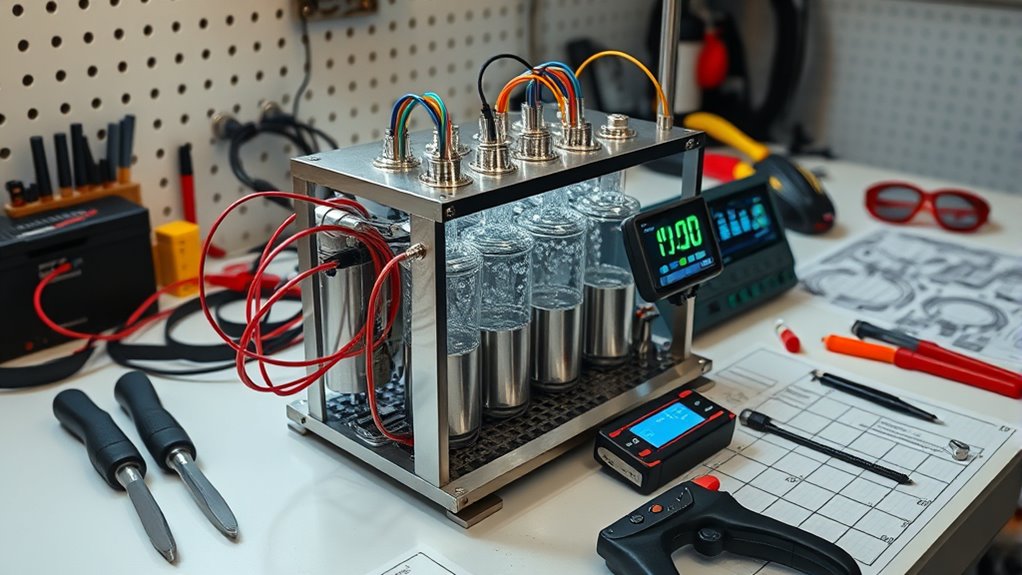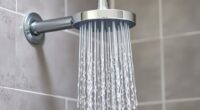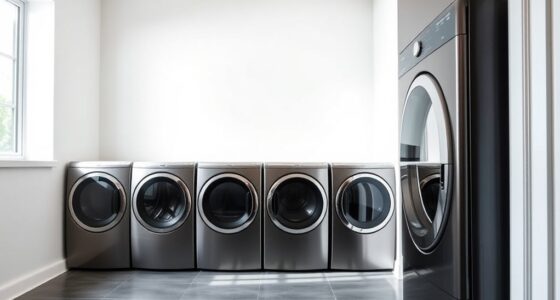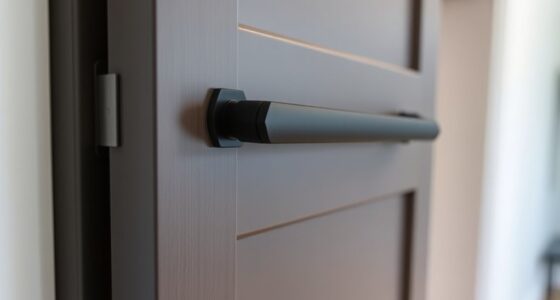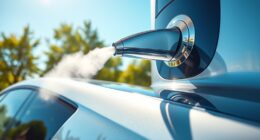If you’re looking for the best PEM electrolyzer kits for DIY projects, I’ve found a variety of options ranging from compact water electrolyzers like the iDili PEM device to high-purity hydrogen generators and industrial-grade modules. Whether you want something easy to assemble for home use, or a professional setup for research, there’s a kit for you. Keep going to discover detailed features, performance tips, and what factors to contemplate for your perfect build.
Key Takeaways
- Highlight compact, easy-to-assemble PEM electrolyzer kits suitable for DIY projects and home use.
- Emphasize kits with high gas purity, safety features, and reliable performance for enthusiasts.
- Include options with straightforward assembly instructions, labeled components, and modular designs.
- Focus on kits compatible with standard power supplies and high-quality materials for durability.
- Provide insights into materials, water requirements, and maintenance to ensure optimal operation for hobbyists.
iDili PEM Electrolyzer for Hydrogen-Rich Water Generation
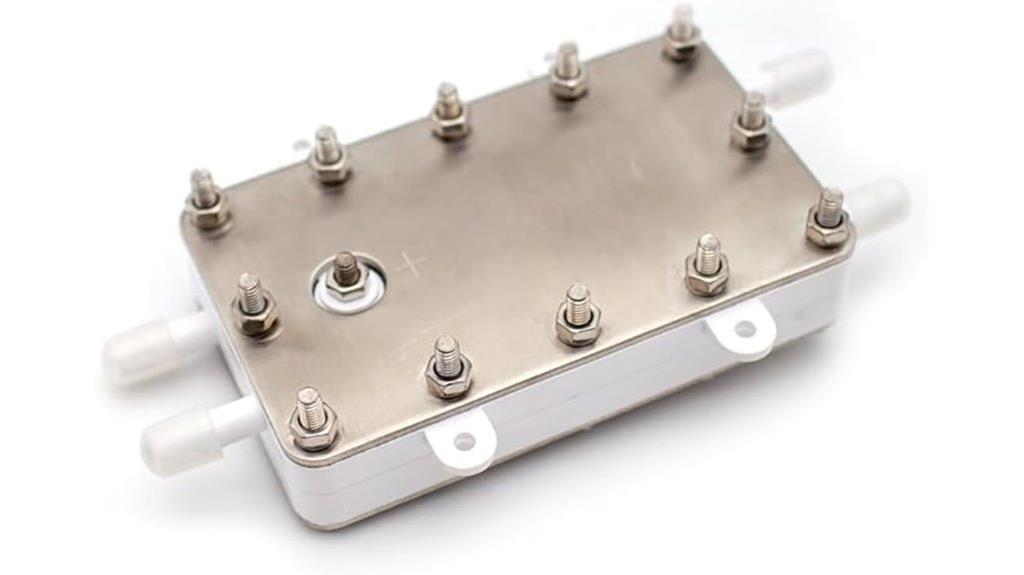
If you’re looking to generate hydrogen-rich water efficiently, the iDili PEM Electrolyzer is an excellent choice, especially for those who want a compact, easy-to-integrate device. Made from durable ABS and featuring platinum-coated electrodes, it ensures effective electrolysis. Its small size—139x82x39.1mm—and lightweight design of just 0.34kg make it perfect for home use or DIY projects. It supports water pressures up to 0.4MPA and operates at voltages below 12V and currents under 7A. With water flow rates of up to 1L/min at the cathode, it delivers reliable hydrogen production without the need for batteries, fitting seamlessly into your existing water systems.
Best For: individuals seeking a compact, efficient, and easy-to-integrate device for generating hydrogen-rich water at home or for DIY projects.
Pros:
- Compact and lightweight design makes it ideal for home use and portability
- Made from durable ABS with platinum-coated electrodes ensures efficient electrolysis and longevity
- Supports water pressures up to 0.4MPA and operates without batteries for seamless integration
Cons:
- Limited water flow rate of up to 1L/min, which may not suit high-demand applications
- No included accessories or additional features beyond the electrolyzer unit
- Slightly higher price point compared to basic water electrolyzing devices
50ML/MIN PEM Electrolyzer Hydrogen Generator Hydrogen-Rich Machine
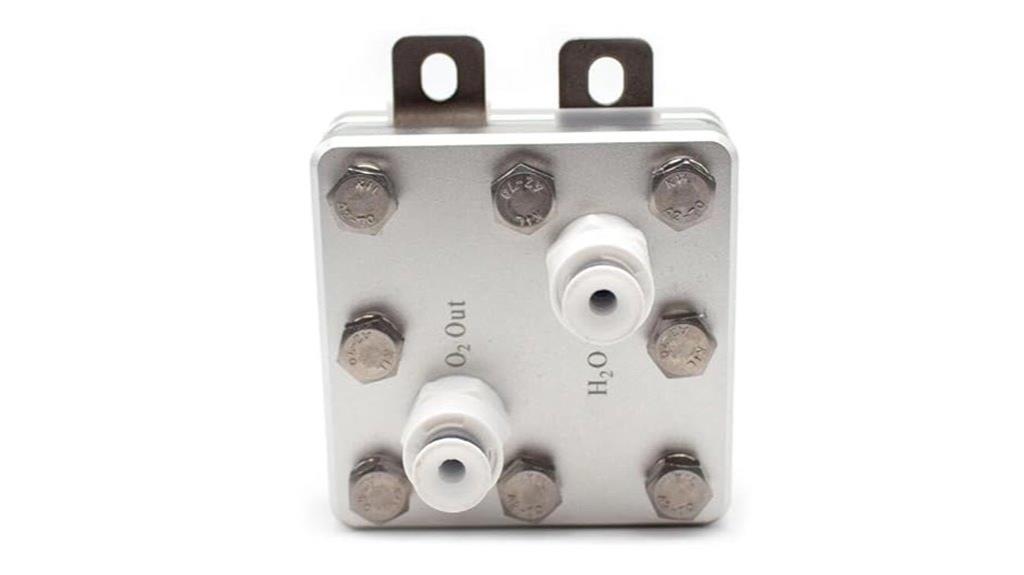
The 50ML/MIN PEM Electrolyzer Hydrogen Generator is an ideal choice for professionals and enthusiasts who need a reliable source of high-purity hydrogen for medical, industrial, or agricultural applications. It produces hydrogen at 50ml/min with excellent purity, suitable for hydrogen water machines, baths, stations, and agriculture. Built with high-quality materials like space-grade titanium and a durable membrane, it guarantees safety and long-lasting performance up to 10 years. Operating on a simple water electrolysis process with no harmful chemicals, it’s safe and easy to maintain. Its compact size (67x67x22mm) and low water consumption make it perfect for various setups requiring stable, efficient hydrogen generation.
Best For: professionals and enthusiasts seeking a reliable, high-purity hydrogen source for medical, industrial, and agricultural applications in compact setups.
Pros:
- Produces high-purity hydrogen suitable for sensitive medical and industrial use
- Durable construction with space-grade titanium ensures safety and long lifespan up to 10 years
- Compact size and low water consumption make it easy to integrate into various systems
Cons:
- Requires proper vertical setup for gravity circulation, which may limit installation flexibility
- Limited hydrogen output capacity of 50ml/min, possibly insufficient for large-scale needs
- Needs a stable constant current power supply (3-5V, 7A) for optimal operation
Quick Quality Electrolysis Tester for Household Water Testing
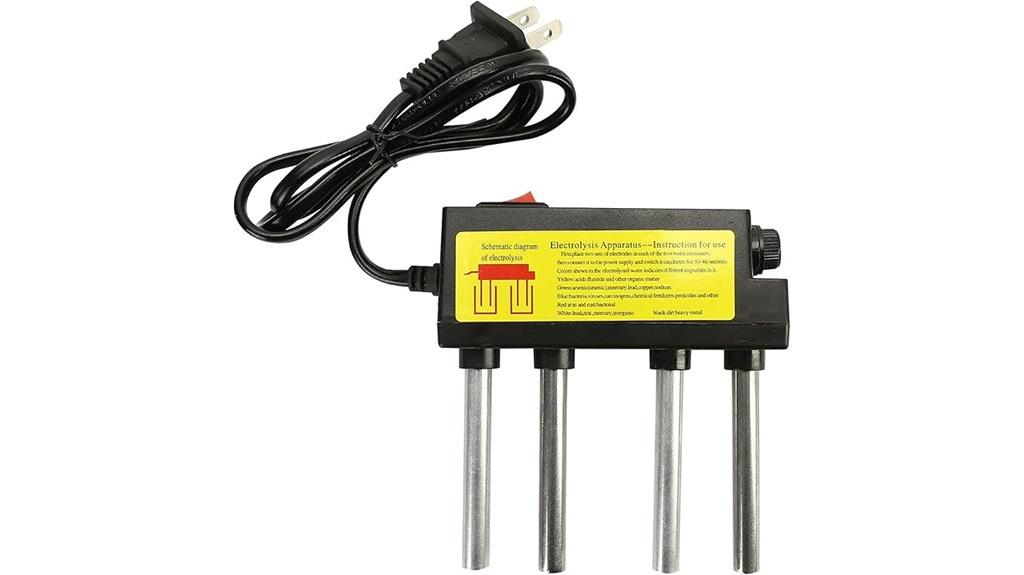
The Quick Quality Electrolysis Tester is an ideal tool for homeowners who want a straightforward way to assess their water’s purity without extensive training or equipment. Compact and lightweight, it quickly reveals metal contaminants by producing visible color changes in water samples. Simply fill two glasses—one with tap water, one with purified water—insert the electrodes, and activate the device for about 30 seconds. Clear water indicates low dissolved solids, while colored precipitates show higher metal content. It’s an affordable, easy-to-use device perfect for monitoring household water quality, helping you identify contamination and verify filtration effectiveness. Just remember to handle it safely and replace the electrodes periodically.
Best For: homeowners seeking a simple, visual method to monitor their household water quality and detect metal contaminants easily at home.
Pros:
- Compact and lightweight, making it easy to handle and store
- Provides quick, visual results to assess water purity without complex equipment
- Affordable and straightforward, ideal for everyday household use
Cons:
- Requires frequent replacement of metal electrodes due to degradation
- Safety concerns due to electrical hazards, sparks, and shocks if improperly used
- Not a precise or laboratory-grade testing device, offering only qualitative assessments
PEM Electrolyzer Module for Hydrogen Production
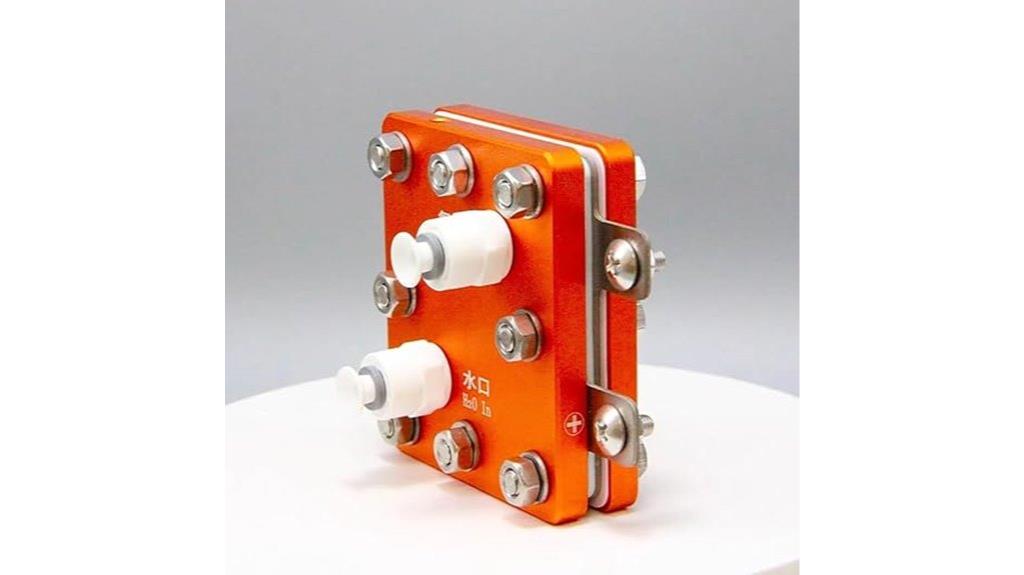
Looking for a reliable solution to produce high-purity hydrogen in various settings? The PEM Electrolyzer Module is an excellent choice, generating 99.99% pure hydrogen through water electrolysis with a Nafion membrane. Its compact, industrial design makes it perfect for labs, fuel cells, renewable energy projects, and industrial use. Built with advanced safety features like leak-proof sealing, it ensures safe, isolated outputs for hydrogen and oxygen. With a lifespan of 3–5 years and low maintenance, it provides consistent, efficient performance. Its high-quality materials and certified durability guarantee reliable operation, making it a versatile, safe option for hydrogen production in many applications.
Best For: laboratories, renewable energy projects, and industrial facilities seeking reliable, high-purity hydrogen production solutions.
Pros:
- Produces 99.99% pure hydrogen with secure, leak-proof separation of gases.
- Compact, durable design suitable for various industrial and research environments.
- Low maintenance with a lifespan of 3–5 years, ensuring long-term reliable operation.
Cons:
- Limited hydrogen output rate of 100mL/min, which may not meet very high-volume needs.
- Requires deionized water input and proper handling to maintain optimal performance.
- Operating temperature range (10°C–60°C) may restrict use in extreme environments.
Water Quality TDS Water Tester
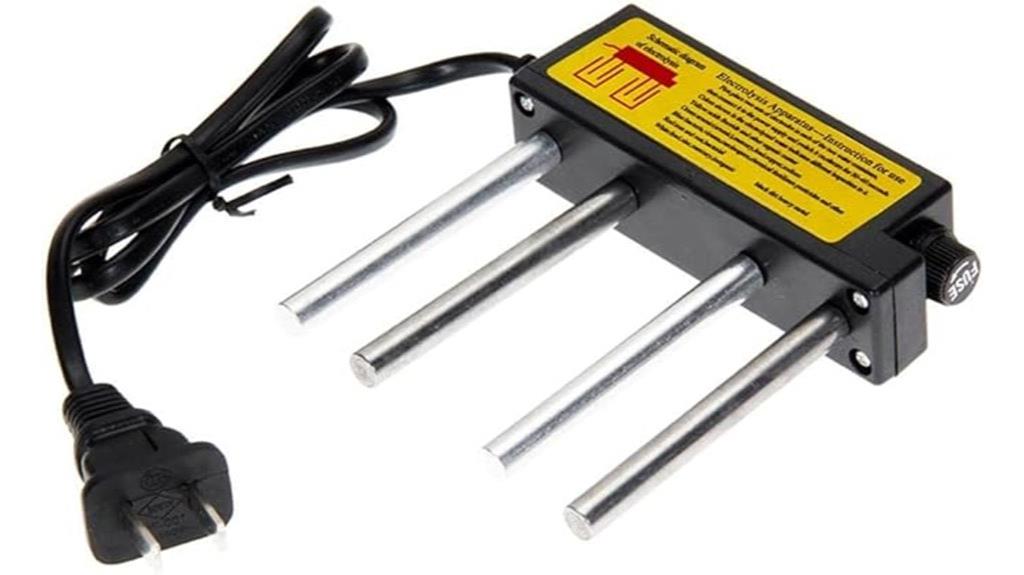
Are you seeking an easy and reliable way to assess household water quality? The Water Quality TDS Water Tester makes it simple. Compact and straightforward, it includes an electrolyzer, iron bars, and aluminum bars for quick testing. Just connect the components as instructed, and the device visually shows whether your water has high or low TDS levels. It’s designed for safe, hassle-free use without complex procedures. Whether you’re checking tap water or well water, this tester provides clear results to help you ensure your water’s quality. It’s an essential tool for anyone wanting quick, accurate insights into their household water.
Best For: households and individuals seeking an easy, reliable way to quickly assess water quality and TDS levels without complex procedures.
Pros:
- Compact and portable design for convenient household use
- Simple, visual indication of high or low TDS water for quick assessment
- Easy to operate with minimal setup and no need for technical expertise
Cons:
- May require careful handling to avoid electric shock during use
- Limited to basic TDS testing; does not measure specific contaminants or ions
- The device’s accuracy can be influenced by water temperature and calibration needs
Electrolysis Power Supply for Rust Remover for Metal
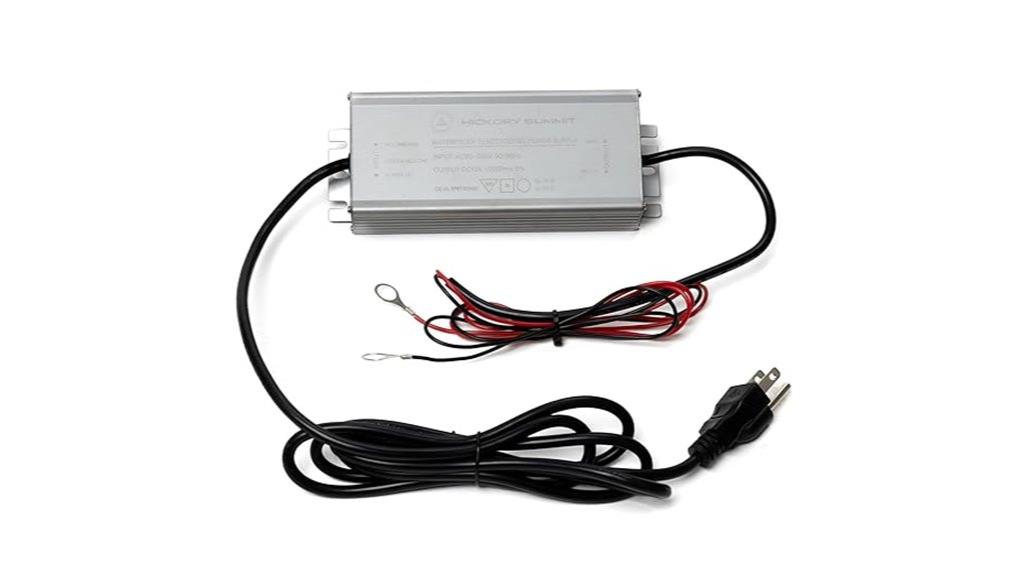
If you’re seeking an affordable and reliable power supply specifically engineered for rust removal, the PEM Electrolyzer Kit offers a user-friendly solution. This 12V, 1A power supply is designed for safe, efficient rust removal on metal objects like tools, coins, and car parts. It features safety protections such as auto-shut-off and overheating prevention, plus an IP67 waterproof rating. The kit includes a sacrificial metal plate, basket, and transformer, making it easy to set up and use. While it produces hydrogen gas, proper ventilation is essential. Overall, it’s a cost-effective choice for DIYers looking to restore metal items safely and effectively.
Best For: DIY enthusiasts, hobbyists, and small businesses seeking a safe, effective, and affordable solution for rust removal on various metal items.
Pros:
- Easy to set up and use with included accessories like sacrificial plates and baskets.
- Safe features such as auto-shut-off and overheating protection ensure user safety.
- Fast rust removal, often completing projects overnight with visible bubbling during operation.
Cons:
- Produces hydrogen gas, requiring proper ventilation to prevent buildup.
- Lacks an indicator light or power switch, which could enhance user convenience.
- May seem costly compared to generic power supplies, though it offers specialized safety and features.
1pcs Experimental Acrylic Electrolyzer Cell Kit
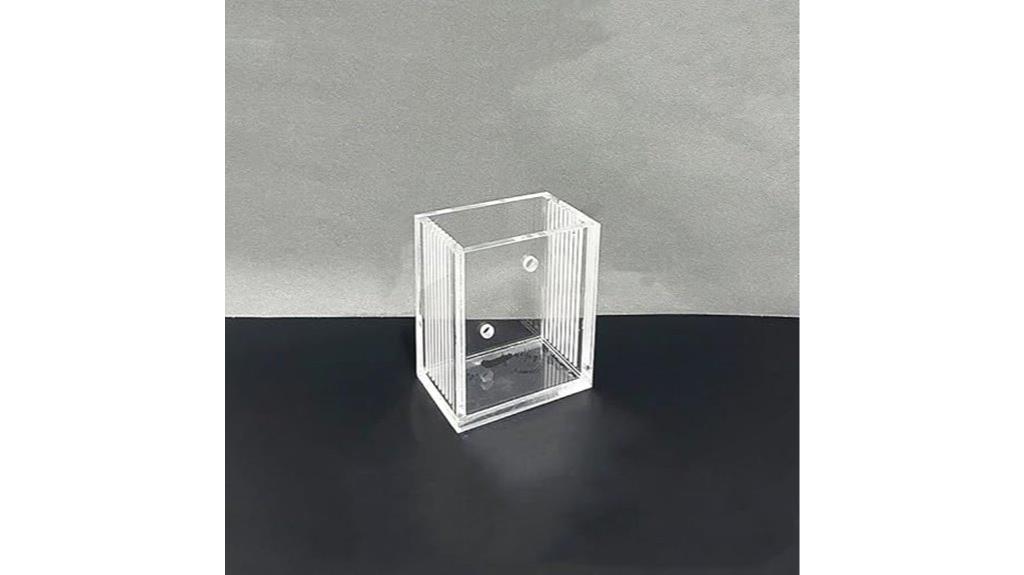
The pcs Experimental Acrylic Electrolyzer Cell Kit is an excellent choice for educators, researchers, and DIY enthusiasts seeking a versatile and reliable platform for electrolysis experiments. Its 10x10cm acrylic design provides transparency and durability, making it easy to observe reactions. The kit includes both standard and recirculating water cells, with the latter supporting more complex experiments thanks to its 500ml capacity. Multiple thickness options (0.01 to 0.3mm) allow customization for different needs. Whether for educational demonstrations or scientific research, this modular setup adapts well to various projects, offering a dependable solution for anyone exploring electrolysis.
Best For: educators, researchers, and DIY science enthusiasts seeking a customizable and transparent electrolyzer platform for experiments and demonstrations.
Pros:
- Versatile with multiple thickness options for tailored experimental setups
- Transparent acrylic design allows easy observation of electrolysis reactions
- Includes both standard and recirculating water cells for diverse applications
Cons:
- Limited to 10x10cm size, which may restrict larger-scale experiments
- Customization options may require additional contact with suppliers
- Acrylic material, while durable, can be prone to scratching over time
iDili PEM Electrolyzer for Hydrogen Gas Production
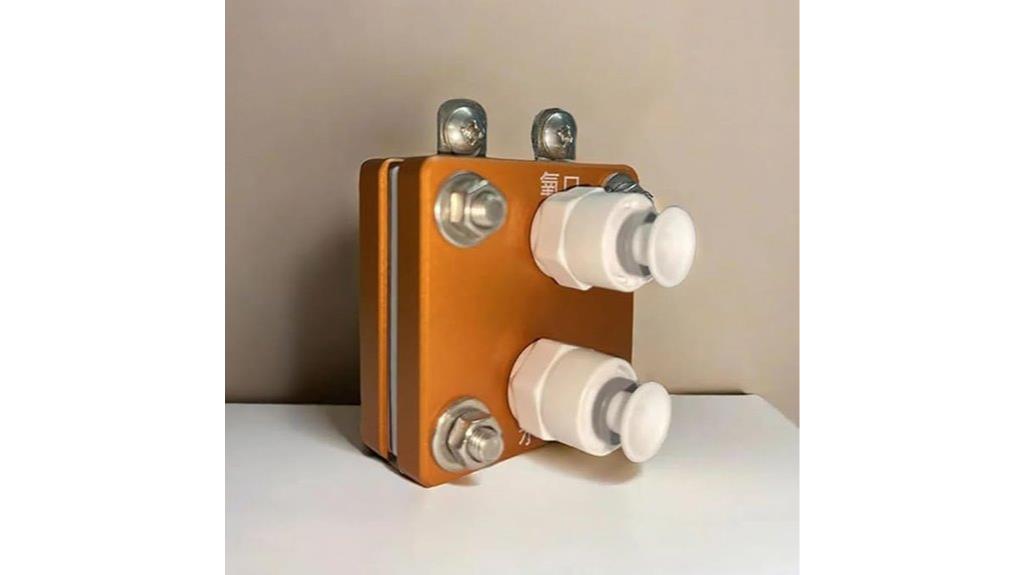
The iDili PEM Electrolyzer is an ideal choice for laboratories, fuel cell developers, and industrial hydrogen users seeking a reliable, high-purity hydrogen source. It produces ultra-pure hydrogen (99.99%) and oxygen efficiently with minimal maintenance, thanks to its durable, corrosion-resistant materials and Nafion membrane. Compact and space-saving, it operates within a temperature range of 10°C-60°C and offers a hydrogen output of 60 mL/min. Designed for long-term stability, it requires only deionized water and meets international safety standards. Manufactured by iDili, this electrolyzer provides a safe, environmentally friendly solution for consistent hydrogen production in various settings.
Best For: laboratories, fuel cell researchers, and industrial hydrogen users seeking a reliable, high-purity hydrogen supply system.
Pros:
- Produces ultra-pure hydrogen (99.99%) with oxygen efficiently and safely
- Compact, space-efficient design suitable for various operational environments
- Long-lasting with corrosion-resistant materials and a lifespan of over 10,000 hours
Cons:
- Requires a steady supply of deionized or purified water without additional chemicals
- Operating temperature range (10°C-60°C) may limit use in extreme environments
- Limited to hydrogen output of 60 mL/min, which may not meet high-volume industrial demands
KICHOUSE Water Electrolysis Teaching Kit for Chemistry Education
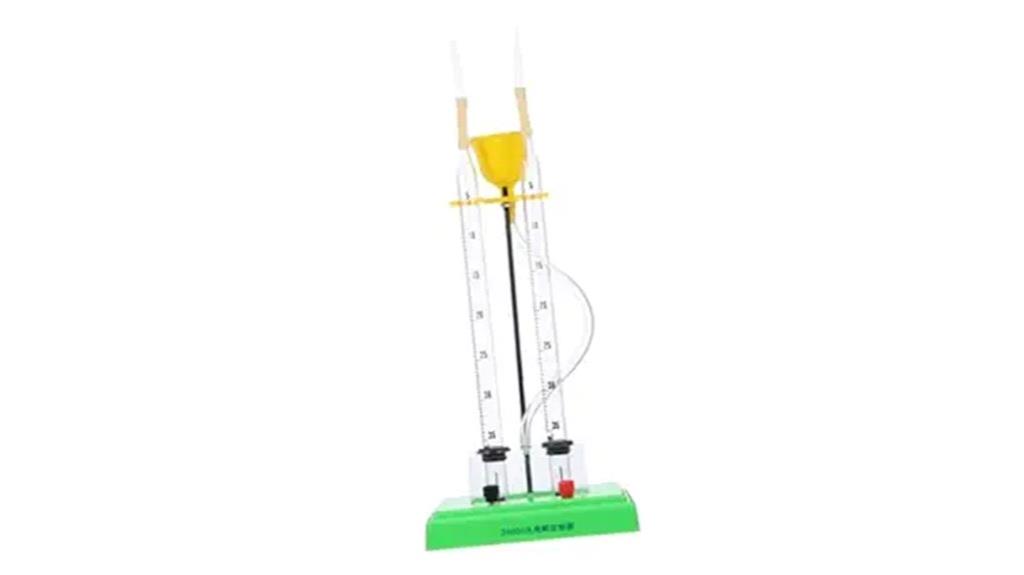
Designed for educators and students seeking an engaging, hands-on chemistry experience, the KICHOUSE Water Electrolysis Teaching Kit offers a reliable and durable solution. Made from sturdy plastic, it withstands repeated classroom use while providing clear visualization of water electrolysis in action. This kit makes complex concepts like oxygen and hydrogen production accessible, helping students grasp chemical reactions firsthand. Its user-friendly design ensures easy setup and operation, even for those without extensive technical background. Plus, it includes electrolyte testing tools and additional experimental equipment, allowing for all-encompassing experiments and reinforcing key learning outcomes. It’s an excellent resource for interactive chemistry education.
Best For: educators and students seeking an engaging, hands-on chemistry demonstration of water electrolysis and related processes.
Pros:
- Made from durable plastic for long-term classroom use
- Provides clear visualization of electrolysis reactions to enhance understanding
- Includes electrolyte testing tools and additional equipment for comprehensive experiments
Cons:
- May require supervision to ensure proper handling and safety during experiments
- Limited to water electrolysis demonstrations, not suitable for advanced or industrial applications
- Some components might need replacement after extensive use or mishandling
PEM Electrolyzer Stack Hydrogen Generator Replacement Part 200ml/min
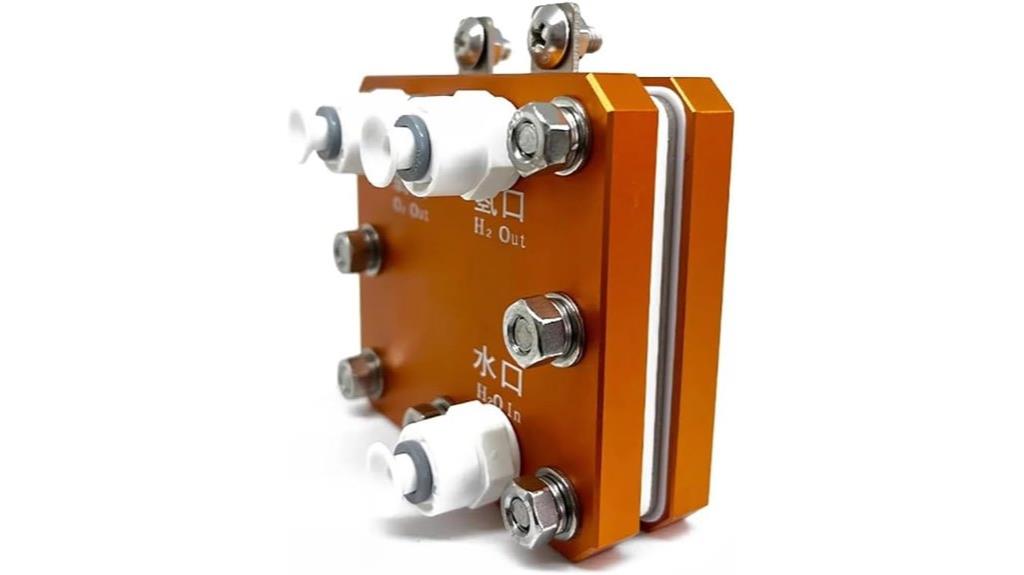
If you’re seeking a reliable replacement part for high-purity hydrogen generation, the PEM Electrolyzer Stack Hydrogen Generator Replacement Part 200ml/min is an excellent choice. This compact unit measures 88×45×90 mm and delivers 200 ml/min of hydrogen, with 100 ml/min of oxygen. It features a proton exchange membrane electrode, built with corrosion-resistant materials for durability, and is designed to last over 10,000 hours. Operating at 3.5V with a constant 26A current, it’s compatible with systems requiring high-purity hydrogen. Ideal for DIY projects, this replacement part guarantees stable performance and easy integration into your hydrogen generation setup.
Best For: DIY enthusiasts and professionals seeking a reliable, high-purity hydrogen generator replacement part for their hydrogen production systems.
Pros:
- Compact size (88×45×90 mm) makes it easy to integrate into various setups
- Long-lasting with a lifespan of over 10,000 hours and corrosion-resistant construction
- Delivers consistent high-purity hydrogen output at 200 ml/min, suitable for precision applications
Cons:
- Operates at a fixed voltage of 3.5V and current of 26A, limiting adjustable settings
- Requires water with conductivity ≤5 μS/cm and temperature control (10-50°C) for optimal performance
- May need technical knowledge for proper installation and system integration
20Pcs Electrolyzer Replacement Rods for Electrolysis Devices
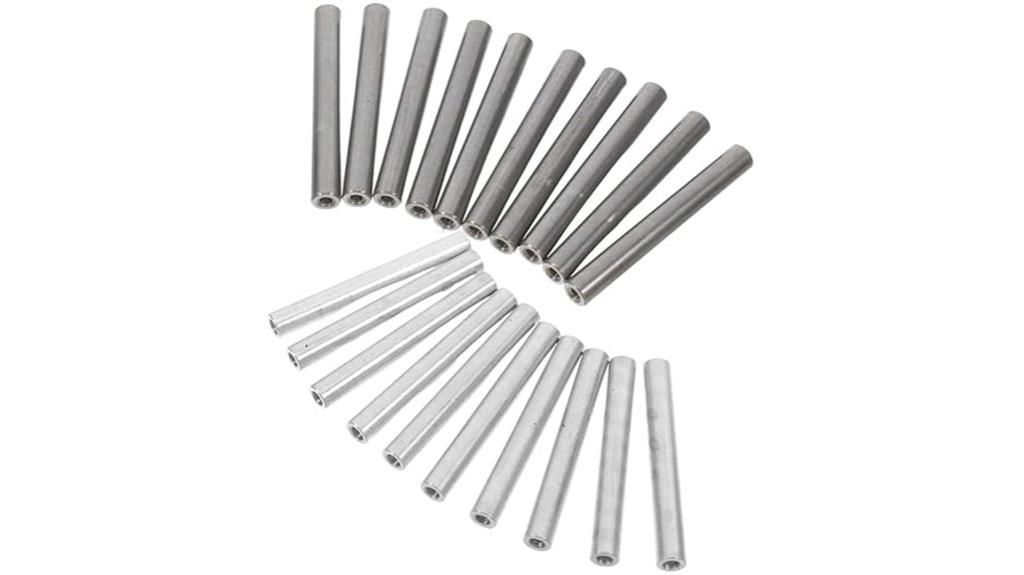
For researchers and hobbyists working with electrolysis devices, these 20-piece electrolyzer replacement rods offer a reliable and versatile solution. Comprising 10 iron and 10 aluminum rods, they are compatible with various electrolysis instruments, including rectangular models. Made from durable materials, each rod measures approximately 7 x 0.8 x 0.8 cm, ensuring high conductivity and long-lasting performance. They’re easy to install and replace, making maintenance straightforward. These rods are perfect for scientific research, household electrolysis projects, and industrial applications, providing stable, efficient operation across a wide range of devices. Their versatility and durability make them a valuable addition to any electrolysis setup.
Best For: researchers, hobbyists, and professionals seeking reliable, durable replacement rods for various electrolysis devices in scientific, household, or industrial settings.
Pros:
- High conductivity ensures efficient and stable electrolysis performance
- Compatible with a wide range of electrolysis instruments, including rectangular models
- Easy to install and replace, reducing maintenance time and device downtime
Cons:
- May require specific sizes or materials for certain specialized devices
- Aluminum and iron rods may corrode over prolonged use if not properly maintained
- Limited to electrolysis applications; not suitable for other types of electrochemical processes
Lab Water Electrolysis Apparatus for Hydrogen and Oxygen Production Teaching Demonstration
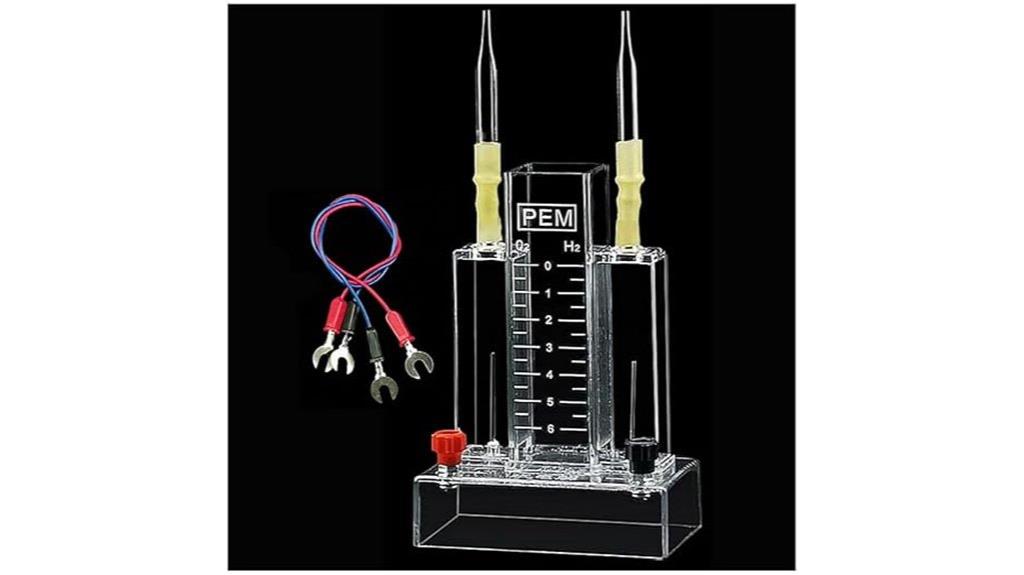
The Lab Water Electrolysis Apparatus is an excellent choice for educators and students seeking a straightforward, cost-effective way to demonstrate hydrogen and oxygen production. It features a compact design with a plastic container, metal alloy electrodes, a gas nozzle, and connecting wires, making it ideal for classroom demonstrations and lab use. To operate, fill with water, connect to a 12V DC power supply, and add a small amount of sulfuric acid or sodium hydroxide to boost conductivity. Gases are produced within minutes, providing a clear visual of water’s chemical breakdown. While simple and inexpensive, it’s important to recognize its limitations and follow safety precautions during use.
Best For: educators and students seeking a simple, affordable demonstration tool for water electrolysis and gas production.
Pros:
- Easy to set up and operate with minimal training
- Compact and cost-effective, suitable for classroom use
- Provides clear visual demonstration of hydrogen and oxygen generation
Cons:
- Uses ordinary metal alloy electrodes, which may limit efficiency and longevity
- Not a high-performance or industrial-grade electrolyzer
- May require additional safety precautions during hydrogen verification and handling
Electrolyzer Demonstrator Ion Exchange Membrane Water Electrolysis Kit
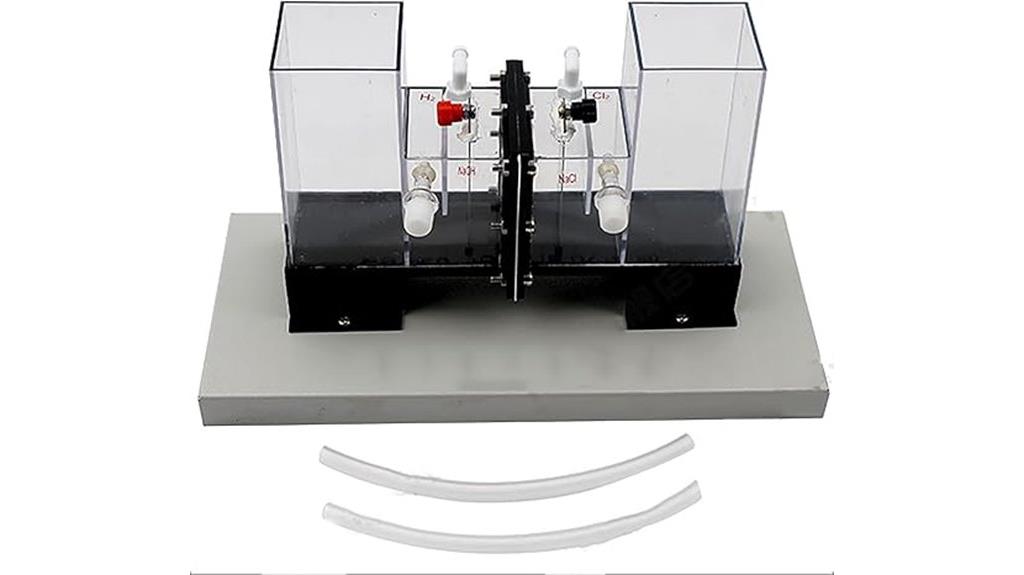
Designed for educational and laboratory settings, the Electrolyzer Demonstrator Ion Exchange Membrane Water Electrolysis Kit efficiently converts saturated brine into high-purity sodium hydroxide, making it an excellent choice for teachers, students, and researchers seeking a hands-on demonstration of water electrolysis. It features an independent electrolyzer, a 12V variable power supply, and high-quality electrodes made of precious metals like platinum, ruthenium, and gold. The ion exchange membrane selectively allows cations to pass, producing caustic soda while preventing gases and anions. This kit offers practical insight into electrolysis, ion exchange, and the chemistry behind sodium hydroxide production, making learning engaging and tangible.
Best For: educators, students, and researchers seeking an interactive demonstration of water electrolysis and ion exchange processes in educational or laboratory settings.
Pros:
- Facilitates hands-on learning of electrolysis and ion exchange principles
- Produces high-purity sodium hydroxide for educational demonstrations
- Made with durable, high-quality electrodes like platinum, ruthenium, and gold
Cons:
- Requires a power supply and proper handling to ensure safety
- Limited to small-scale laboratory or classroom use, not industrial applications
- May involve costs associated with high-quality electrode materials
PEM Electrolyzer for Hydrogen Gas Production
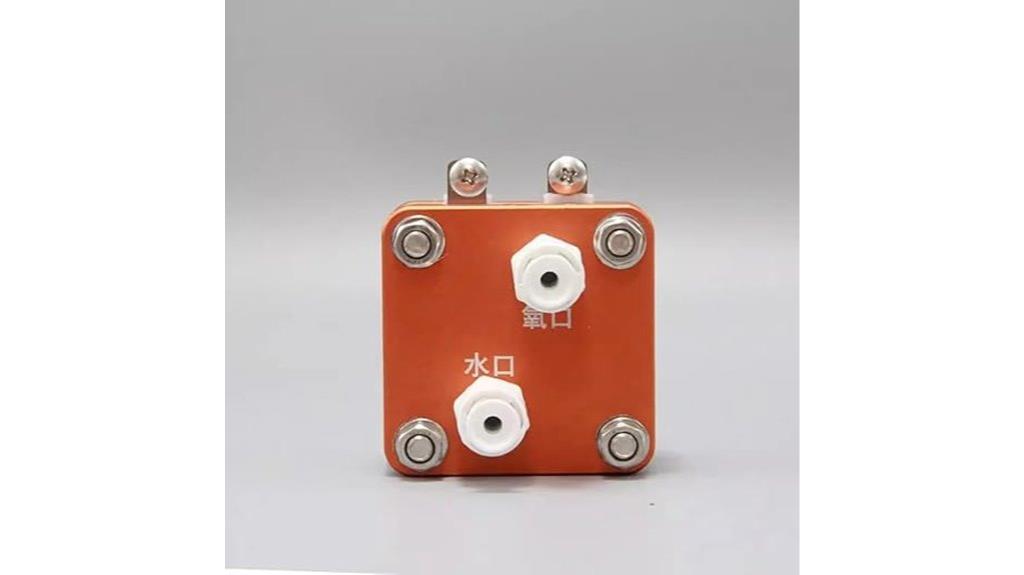
Looking to produce ultra-pure hydrogen reliably and efficiently? A PEM electrolyzer is an excellent choice. It uses a Nafion proton exchange membrane for stable, high-purity hydrogen output, with a lifespan of over 10,000 hours. Its compact design fits easily into various setups, supporting continuous operation at 8A current and producing about 60mL of hydrogen per minute. The electrolyzer operates safely with minimal maintenance, emitting zero ozone and requiring only deionized water. Its robust, environmentally friendly design makes it ideal for lab use, fuel cell projects, or industrial applications. Plus, its certified quality guarantees consistent, high-purity gas production.
Best For: researchers, laboratories, and industrial facilities seeking reliable, high-purity hydrogen production with minimal maintenance and environmental impact.
Pros:
- Produces ultra-pure hydrogen (99.99%) with zero ozone emissions, ensuring environmentally friendly operation.
- Long lifespan of over 10,000 hours with stable, continuous performance.
- Compact and robust design suitable for various industrial and laboratory setups with easy integration.
Cons:
- Limited maximum hydrogen pressure range (0–0.8 MPa), which may not meet high-pressure storage needs.
- Operating at a fixed current of 8A, potentially limiting scalability for higher output requirements.
- Requires deionized or purified water, necessitating additional water treatment in some applications.
Factors to Consider When Choosing a PEM Electrolyzer Kit DIY
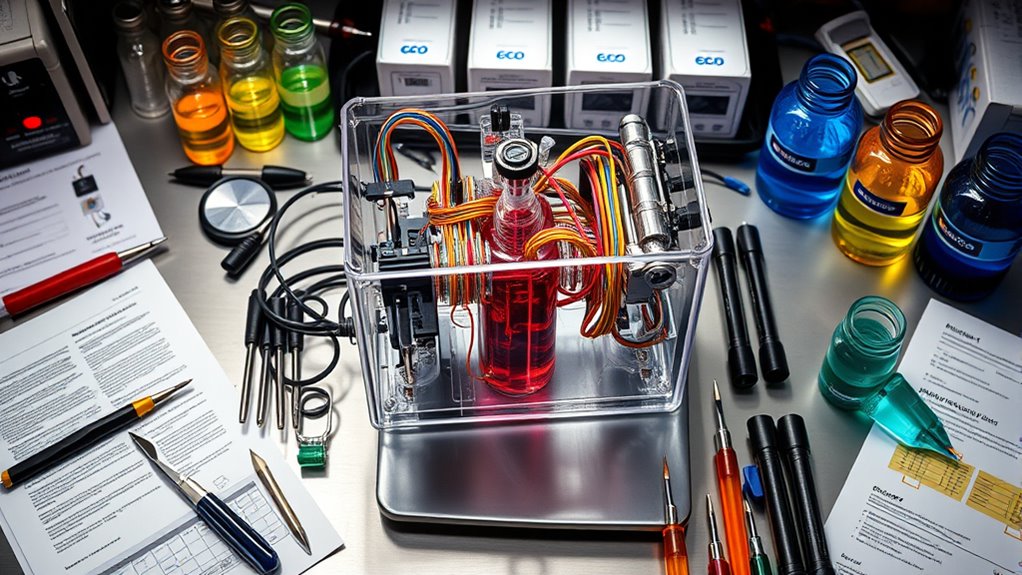
When choosing a PEM electrolyzer kit for DIY use, I focus on several key factors to guarantee safe and efficient operation. I consider compatibility with different water sources, power requirements, and how easy it is to assemble and maintain. Safety features and the purity of the hydrogen output also play a vital role in my decision-making process.
Compatibility With Water Types
Choosing the right PEM electrolyzer kit depends heavily on the water you plan to use, since not all water sources are suitable for efficient and long-lasting operation. Ideally, you want to use purified, deionized, or distilled water with TDS levels below 10 ppm for ideal performance. Some kits require strict water quality standards; using water with high mineral content or impurities can reduce efficiency and cause corrosion or scaling, shortening the lifespan of the components. It’s also important to check if the kit can handle recycled or low-pressure water sources, especially if gravity circulation or specific pressure ranges are involved. Ensuring that the materials, like membranes and electrodes, resist corrosion and scaling from your water type is vital for durability and consistent hydrogen production.
Power Supply Requirements
Selecting the right power supply for your PEM electrolyzer kit is essential to guarantee safe, efficient, and reliable hydrogen production. First, ensure the voltage matches your electrolyzer’s rated range, usually between 3V and 12V, to avoid damage and maximize efficiency. Check that the power supply can deliver the necessary current, often up to 7A or more, to support optimal hydrogen output. It’s crucial to use a stable, regulated power source to prevent voltage fluctuations that could harm the membrane or electrodes. Safety features like overcurrent protection, short-circuit prevention, and overheating shutdown are vital for reliable operation. Lastly, confirm the power supply is compatible with DC sources, avoiding AC inputs unless properly rectified and filtered. These considerations help ensure safe, effective, and consistent performance.
Safety and Leak Prevention
Ensuring safety and preventing leaks are critical when setting up a DIY PEM electrolyzer kit. I look for kits with leak-proof sealing technology and certified safety features to minimize hydrogen or oxygen leaks during operation. It’s essential that the system includes safety mechanisms like automatic shut-off, overpressure protection, and proper ventilation to reduce gas buildup risks. I prefer electrolyzers made from high-quality, corrosion-resistant materials such as Nafion membranes and titanium electrodes, which guarantee long-term safety and durability. Additionally, I verify that the kit complies with international safety standards and certifications, giving me confidence it meets safety regulations. Regular inspection and maintenance of seals, connections, and safety devices are crucial to prevent leaks and keep the system operating safely over time.
Ease of Assembly
When assembling a DIY PEM electrolyzer kit, ease of setup can make a significant difference in your overall experience. A kit with clear, step-by-step instructions and labeled components helps guarantee you understand each part’s purpose, reducing confusion. The fewer parts and simpler connections, the quicker and more error-free your assembly becomes. Compatibility of electrodes, membranes, and connectors with standard sizes makes fitting everything together smoother. Pre-assembled or modular components eliminate the need for advanced technical skills, especially for beginners. Additionally, user-friendly tools and clear safety guidelines included in the kit help prevent mistakes and promote safe assembly. Overall, a well-designed kit minimizes frustration, shortens build time, and boosts confidence in creating a reliable electrolyzer system.
Purity of Output Gas
Achieving high-purity output gases is essential for the safety and effectiveness of your DIY PEM electrolyzer, so paying attention to key factors can make all the difference. Look for kits that produce hydrogen and oxygen with at least 99.99% purity, guaranteeing safe handling and optimal performance. Verify that the system uses high-quality Nafion proton exchange membranes, which are critical for effective separation and maintaining purity. It’s also important that the electrolyzer operates without harmful electrolytes or additives that could contaminate the gases. Additionally, check if the design supports stable gas purity over long periods, ideally allowing continuous operation for thousands of hours. Finally, safety features like leak-proof seals and proper gas separation are essential to prevent cross-contamination and ensure your output gases stay pure and safe.
Durability of Components
The longevity of a PEM electrolyzer largely depends on the quality and durability of its components. High-quality membranes, like Nafion, usually last 4 to 5 years under normal conditions, ensuring efficient proton exchange and gas separation. Electrodes made from platinum-coated or corrosion-resistant metals provide long-term stability, preventing degradation from electrochemical wear. Sealed housings crafted from durable plastics like ABS or industrial metals shield internal parts from environmental damage, extending their lifespan. Proper maintenance, including regular cleaning and timely replacement of worn parts, is essential to preserve component integrity. When choosing a kit, I recommend focusing on these materials, as they directly influence the system’s durability and performance over time. Investing in quality components means fewer replacements and more reliable operation in the long run.
Cost and Maintenance
Considering the costs and maintenance involved in choosing a PEM electrolyzer kit, it’s important to evaluate both the upfront investment and ongoing expenses. More advanced models tend to be pricier but offer better durability and performance, which can save money over time. Maintenance usually involves inspecting and replacing electrodes or membranes, costing between $20 and $100 depending on the part and model. Long-term costs also include the need for purified or deionized water, which might require additional equipment or consumables. Kits made with durable, corrosion-resistant materials and sealed designs typically need less frequent maintenance, reducing downtime. Additionally, check the availability and cost of replacement parts like electrodes and membranes to keep ongoing upkeep affordable and manageable.
Frequently Asked Questions
What Safety Precautions Are Necessary During DIY PEM Electrolyzer Assembly?
When assembling a DIY PEM electrolyzer, I make sure to wear safety goggles and gloves to protect against acid and hydrogen. I work in a well-ventilated area to prevent gas buildup and avoid sparks or open flames. I double-check connections for leaks and handle all components carefully. Following these safety steps keeps me safe while I enjoy exploring hydrogen production at home.
How Do Operating Conditions Affect Hydrogen Production Efficiency?
Operating conditions are like the secret recipe for maximum hydrogen juice! When I crank up the temperature, I see hydrogen bubbles explode like fireworks, but too hot can damage the system. Keep the right voltage and pressure, and you’ll get a steady, powerful flow. If I ignore these, efficiency drops faster than a rocket, wasting energy and diminishing output. So, fine-tuning these conditions is key to supercharging hydrogen production!
Can These Kits Be Customized for Higher Output or Different Applications?
Yes, many of these kits are customizable for higher output or specific applications. I often modify them by adjusting the electrolysis parameters, upgrading components like membranes and electrodes, or adding extra modules. Just keep in mind, I make sure to follow safety guidelines and understand the system’s limits before scaling up. With some tinkering, you can tailor these kits to meet your unique hydrogen production needs efficiently.
What Maintenance Is Required for Long-Term Electrolyzer Performance?
Maintaining your electrolyzer isn’t complicated, but neglecting it can lead to decreased performance. I regularly inspect and clean the electrodes, ensuring no buildup reduces efficiency. I also check seals and connections for leaks and replace filters when needed. Using distilled water prevents mineral deposits, and keeping the system in a clean, dry environment extends its lifespan. Consistent maintenance keeps my electrolyzer running smoothly and maximizes its long-term performance.
Are There Legal Restrictions on Producing Hydrogen at Home?
Yes, there are legal restrictions on producing hydrogen at home. I’ve found that regulations vary by location, and in many areas, generating hydrogen without proper permits can be illegal due to safety concerns. It’s essential to check with local authorities or regulations before attempting this. I always recommend prioritizing safety and legal compliance to avoid fines or hazardous situations.
Conclusion
If you’re diving into DIY hydrogen production, choosing the right PEM electrolyzer kit can make all the difference. Did you know that the global hydrogen market is expected to reach over $130 billion by 2030? With the right kit, you can explore this exciting field safely and effectively. Whether for hobby or education, I hope this guide helps you pick the perfect setup to start your hydrogen journey today!
